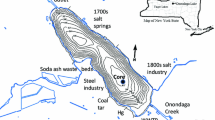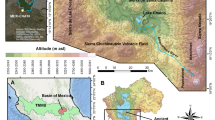Abstract
Detailed examination of sedimentary cores retrieved from Sugan Lake in the northern Qaidam Basin of northwest China’s Tibetan Plateau reveal that fine laminated beddings form in the sediments where water depth exceeds 3 m. Seasonal surface sediments trapped at the bottom of the lake suggest that sediments deposited during summer and autumn are mainly light colored monohydrocalcites, while those deposited in winter are dark organic matter, indicating that varve layers form under modern limnological conditions. Continuous varve sediments comprising four types have accumulated in the upper 5.5 m of Core SG03I from the center of the lake. All types exhibit clear seasonality indicative of annual deposition. Varve counts correspondence with 210Pb dates on recent sediments in the upper core suggest the continuous varves of the upper 5.5 m of the core formed in the late Holocene (2670 a BP). The Sugan Lake varve sequence is the first demonstration of annually laminated sediments reported in arid western China.
Similar content being viewed by others
References
Wang S M, Zhang Z K. New development on the lacustrine sedimentology and environment evolution in China. Chin Sci Bull (in Chinese), 1999, 44(6): 579–587
Anderson R Y, Dean W E. Lacustrine varve formation through time. Paleogeogr Paleoclimatol Paleoecol, 1988, 62: 215–235
Lotter A F. How long was the Younger Dryas-Preliminary evidence from annually laminated sediments of Soppensee (Switzerland). Hydrobiologia, 1991, 214: 53–57
Brauer A, Endres C, Günter C, et al. High resolution sediment and vegetation responses to Younger Dryas climate change in varved lake sediments from Meerfelder Maar, Germany. Quat Sci Rev, 1999, 18(3): 321–329
Hu F S, Slawinski D, Wright H E Jr, et al. Abrupt changes in North American climate during early Holocene times. Nature, 1999, 400: 437–440
Goslar T, Arnold M, Bard E, et al. High concentration of atmostpheric 14C during the Younger Dryas cold episode. Nature, 1995, 377: 414–417
Saarinen T. High-resolution palaeosecular variation in northern Europe during the last 3200 years. Phys Earth Planet In, 1998, 106: 299–309
Liu Q, You H T, Liu J Q. methodology of studying on varved lake sediments and its signigicance. Quat Sci (in Chinese), 2004, 24(6): 683–694
Li W C, Li S J, Pu P M. Review on the high-resolution varved lake sediments as a proxy of Paleoenvironment. Adv Earth Sci (in Chinese), 1999, 14(2): 172–176
Johnson T C, Barry S L, Chan Y, et al. Decadal record of climate variability spanning the past 700 yr in the Southern Tropics of East Africa. Geology, 2001, 29(1): 83–86
Ishihara S, Kato M, Tanimura Y, et al. varved lacustrine sediments and diatom assemblages of lake Fukami, central Japan. Quat Int, 2003, 105: 21–24
Liu J Q, Liu T S, Chu G Q, et al. Maar lake and varve chronology. Quat Sci (in Chinese), 1996, (4): 353–358
Chu G Q, Liu J Q, Liu T S. Discrimination of two kinds of sedimentary laminae in maar lakes of China. Chin Sci Bull, 2000, 45(24): 2292–2295
Chu G Q, Gu Z Y, Xu B, et al. Varve chronology and radiometric dating (137Cs, 210Pb) from the sihailongwan Maar, northeastern China. Quat Sci (in Chinese), 2005, 25(2): 202–208
Wang S M, Dou H S. The Records of Lakes in China (in Chinese), Beijing: Science Press, 1998. 485
O’sullivan P E. Annually-laminated lake sediments and the study of quaternary environmental changes—a review. Quat Sci Rev, 1983, 1: 245–313
Qiang M R, Chen F H, Zhang J W, et al. Climatic changes documented by stable isotopes of sedimentary carbonate in Sugan Lake, northeastern Tibetan Plateau of China, since 2 kaBP. Chin Sci Bull, 2005, 50(17): 1930–1939
Chu G Q, Liu J Q, Schettler G, et al. sediment fluxes and varve formation in Sihailongwan, a Maar lake from northeastern china. J Paleolimnol, 2005, 34: 311–324
Dean W E. Determination of carbonate and organic matter in calcareous sediments and sedimentary rocks by loss on ignition: Comparison with other methods. J Sed Petrol, 1974, 44: 242–248
Håkanson L Jansson M. Principium of Lake Sedimentology. Berlin: Springer-Verlag, 1983. 144–190
Renberg I. Improved methods for sampling, photographing and varve counting of varved lake sediments: Boreas, 1981, 10: 255–258
Simola H. Diatom succession in the formation of annually laminated sediment in Lovoj/irvi, a small eutrophicated lake. Ann Bot Fenn, 1977, 14: 143–148
Ojala A E K, Heinsalu A, Saarnisto M, et al. Annually laminated sediments date the drainage of the Ancylus Lake and early Holocene shoreline displacement in central Finland. Quat Int, 2005, 130: 63–73
Ojala A E K, Tiljander M. Testing the fidelity of sediment chronlogy: Comparison of varve and paleomagnetic results from Holocene lake sediments from central Finland. Quat Sci Rev, 2003, 22: 1787–1803
Halfman J D, Johnson T C. High-resolution record of cyclic climatic change during the past 4 ka from lake Turkana, Kenya. Geology, 1988, 16: 496–500
Anderson R Y. Short term sedimentation response in lakes in western United States as measured by automated sampling. Limnol Oceanogr, 1977, 22: 423–433
Lotter A F. Evidence for annual layering in Holocene sediments of Soppensee, Switzerland. Aquat Sci, 1989, 51(1): 19–30
Poth D, Negendank J F W. Palaeoclimate reconstruction at the Pleistocene/Holocene Transition: A varve dated microstratigraphic record from Lake Meerfelder Maar (Westeifel, Germany). In: Negendank J F W, Zolitschka B, eds. Paleolimnology of European Maar Lakes. Berlin: Springer, 1993. 209–222
Deckker P D, Last W M. Modern dolomite deposition in continental, saline lakes, western Victoria, Australia. Geology, 1988, 16: 29–32
Patrick R, Reimer C W. The diatoms of the United States, exclusive of Alaska and Hawaii, Volume 2, Part 1-Entomoneidaceae, Cymbellaceae, Gomphonemaceae, Epithemaceae. Academy of Natural Sciences of Philadelphia Monograph, 1975, 13: 213–214
Kelts K, Hsü K J. Freshwater carbonate sedimentation. In: Lerman A ed. Lakes: Geology, Chemistry, Physics. New York: Spring Verlag, 1978. 295–323
Author information
Authors and Affiliations
Corresponding author
Additional information
Supported by the NSFC (National Natural Science Foundation of China) National Innovation Research Team Project (Grant No. 40421101), and the NSFC Research Projects (Grant Nos. 40301050 and 40301051)
Rights and permissions
About this article
Cite this article
Zhou, A., Chen, F., Qiang, M. et al. The discovery of annually laminated sediments (varves) from shallow Sugan Lake in inland arid China and their paleoclimatic significance. SCI CHINA SER D 50, 1218–1224 (2007). https://doi.org/10.1007/s11430-007-0081-1
Received:
Accepted:
Issue Date:
DOI: https://doi.org/10.1007/s11430-007-0081-1




